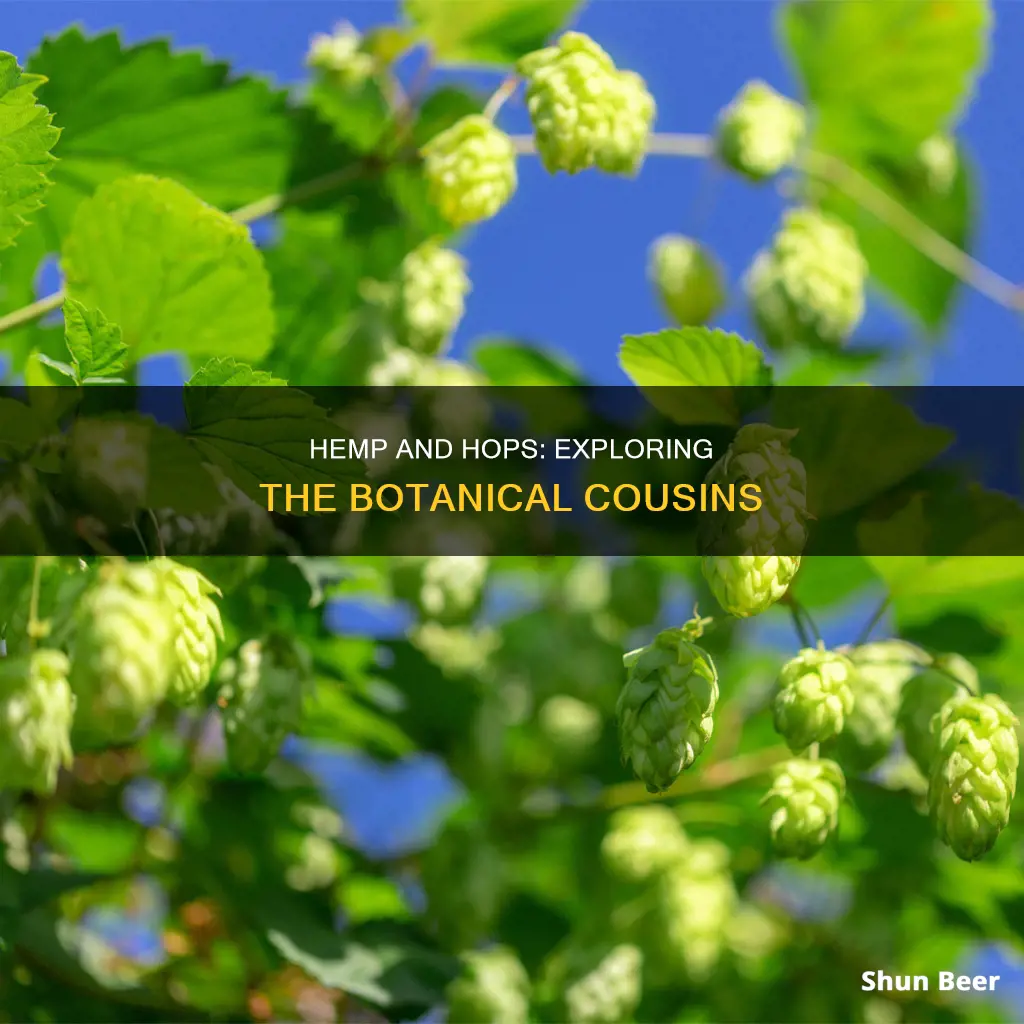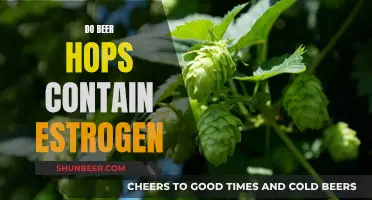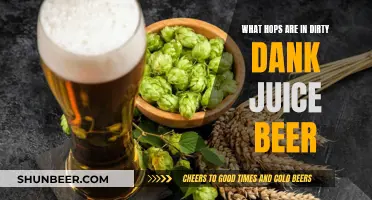
Hemp and hops are closely related, with both plants belonging to the small flowering plant family, Cannabaceae. While they diverged from a common ancestor around 25-27 million years ago, they share a number of similarities in terms of origin, genetics, taxonomy classification, and other key characteristics. Both plants contain terpenes and terpenoids, which are responsible for their distinctive flavours and aromas. While hemp is primarily cultivated for fibre, oil, textiles, and medicinal extracts, hops is a key ingredient in beer, adding bitterness and extending the shelf life of the product.
| Characteristics | Values |
|---|---|
| Taxonomy | Both hops and hemp belong to the family Cannabaceae, which includes 170 species grouped in 11 genera. |
| Evolutionary History | Hops and hemp diverged from a common ancestor about 25-27 million years ago. |
| Physical Appearance | Hemp grows as tall stalks with few leaves and branches, while marijuana grows as short bushy plants. Hops plants grow tall and produce long vines. Both plants have jagged-edged leaves. |
| Chemical Composition | Both plants contain terpenes and terpenoids, which give them their distinctive taste and smell. Hops contain myrcene, caryophyllenes, and other terpenes, while hemp has a more diverse terpene profile. |
| Use | Hemp is used for textiles, medicines, and medicinal extracts, while hops is a key ingredient in beer. |
| Cultivation | Both plants require similar conditions for growth, including female unpollinated plants, specific strains, and growth locales. |
| Processing | Hemp is typically harvested for seed oil or stalks, while hops harvesting focuses on collecting the flower cones for brewing. |
What You'll Learn

Hops and hemp are cousins
The two plants share a common ancestor, which existed around 25-27 million years ago. Since then, they have evolved as separate botanical species, but they still share many similarities. For example, both plants have jagged-edged leaves, similar seeds and pollen, and female inflorescences (flower heads) that contain terpenes and other phytonutrients.
The terpene contents of Cannabis are more diverse than Humulus, but both plants contain terpenes that give them their distinctive flavours and aromas. Hops tend to have a large amount of myrcene, while cannabis has less myrcene and varies more in its terpene profile from one strain to another. Both plants also have sticky, resinous parts that appear to be of similar terpene factories. However, while weed makes cannabinoids, hops make alpha and beta acids.
In addition to their shared lineage and chemical similarities, hops and hemp also have a long history of therapeutic use. Long before hops became a bittering agent in the brewing industry, their flower heads were used in traditional Eurasian cultures to treat restlessness and sleep disturbances, just like cannabis. Hops also have other medicinal benefits, such as easing digestive issues, anxiety, and inflammation.
The close relationship between hops and hemp has led to some interesting developments in the food and beverage industry. For example, hemp-infused beers that contain no CBD or THC have been on the market for years, and with the increasing acceptance of cannabis, we are likely to see more CBD-infused alcoholic beverages in the future.
Hops' Preservative Powers: Keeping Beer Fresh
You may want to see also

They share key ingredients
Hops and hemp are indeed related. They are cousins, having diverged from a common ancestor around 25 to 27 million years ago. They share a family, Cannabaceae (or Cannabinaceae), and a genus, Cannabinaceae, which includes 11 genera and 170 species.
The two plants share several key ingredients, most notably terpenes and terpenoids. Terpenes are organic compounds synthesised by cells, all of which start with a particular base molecule called isoprene. Terpenes are responsible for the distinctive smell of both plants. Hops tend to have a large amount of myrcene (a type of terpene), while cannabis has less myrcene and a more varied terpene profile. Both plants also contain sticky, resinous parts that appear to be of similar terpene factories.
Hops and cannabis also share therapeutic attributes and have been used medicinally for thousands of years. Before hops became a bittering agent in the brewing industry, their flower heads were used in traditional Eurasian cultures to treat restlessness and sleep disturbances, just like cannabis flower heads. Hops are also said to help with digestive issues, anxiety, and inflammation.
In addition to terpenes, hops and cannabis also share tetrahydrocannabinol (THC), a terpenoid. Hops lack the enzyme that could convert cannabigerolic acid into THC, but it can be inserted using genetic engineering, as was done in 2019 for yeast.
The Hoppy Truth: Do All Beers Have Hops?
You may want to see also

They have similar appearances
Hops (Humulus lupulus) and hemp (Cannabis sativa) are two distinct plants with different physical appearances and uses. However, they share some similarities in their evolutionary history, chemical composition, and sensory characteristics, including their appearance.
Hops and hemp belong to the small family of flowering plants known as Cannabaceae, which consists of 170 species grouped into 11 genera. Within this family, the evolutionary relationship between Cannabis and Humulus is particularly strong, which may explain some of their similarities.
One notable similarity between hops and hemp is their shared production of aromatic terpene compounds. Terpenes are responsible for the complex flavours and fragrances associated with both plants. While the terpene profiles of hops and hemp can vary, with hemp exhibiting greater diversity, both plants produce terpenes such as myrcene, caryophyllene, limonene, and pinene. These terpenes contribute to the distinctive aromas and flavours found in hops and hemp.
In addition to their chemical similarities, hops and hemp also share some physical characteristics. Both plants have palmately lobed leaves with stipules and contain cystoliths (calcium carbonate crystals within their cells). These structural similarities were once used to classify them into a single family under the order Urticales. However, with advancements in molecular biology and DNA sequencing, it was later determined that they belong to the family Cannabinaceae, under the order Rosales.
While hops and hemp have distinct evolutionary trajectories and uses, their shared production of terpenes and physical characteristics contribute to their similar appearances and fragrances.
Hops Beer: The Secret Behind the Bitter Buzz
You may want to see also

They have similar uses
Hops (Humulus Lupulus) and hemp (Cannabis Sativa) are indeed related. They are both part of the taxonomic family Cannabinaceae, which also shares a common ancestor with other plant families.
Both plants contain terpenes and terpenoids. Terpenes are organic compounds that give hops and hemp their characteristic taste and smell. Terpenoids, which are derived from terpenes, are the primary active ingredients in both plants. The major bitter compound in hops, alpha acids, is a terpenoid. The primary active ingredient in hemp, tetrahydrocannabinoids, is also a terpenoid.
Humulene, also known as alpha-caryophyllene, is a terpene found in large amounts in hops and provides beer with most of its aroma. Humulene is also present in hemp and was first discovered in hops. It is also found in other plants such as black pepper and salvia. It provides spicy, fresh notes similar to earth and wood.
Hops and hemp also have similar leaves and flowers. Both have leaves with serrated edges, and their flowers grow in a pineapple shape. In addition, both plants are dioecious, meaning they produce both male and female plants, and the crossing of both results in reproduction.
Hops' Role in Brewing: Aromatic and Bitter Beer Balancing
You may want to see also

They have different cultivation processes
While hops and hemp are closely related in origin, genetics, taxonomy classification, and other key characteristics, they have different cultivation processes.
Hemp is a variety of the Cannabis sativa plant, grown specifically for industrial purposes. It is cultivated for the production of paper, textiles, biodegradable plastics, construction materials, and even fuel. On the other hand, hops are important industrial crops grown for their hop cones, which are essential for beer production. Hops are the flowers (also called seed cones or strobiles) of the hop plant Humulus lupulus, a member of the Cannabaceae family of flowering plants.
The cultivation and harvesting of hops involve specific processes such as land preparation, planting, pruning, fertilizing, and harvesting. Hops are typically planted in rows about 2 to 2.5 metres apart, and the stems are pruned to encourage stronger and more even growth. The hop plants are then trained to grow up trellises or strings, allowing them to climb and freeing up energy for crop growth. The cones are harvested at the end of summer when they reach technical maturity, and the bines are cut, separated, and dried in an oast house to reduce moisture content.
In contrast, hemp cultivation varies depending on its intended use. For example, hemp grown for fibre harvests may involve longer cuts, while seed harvests focus on the upper portion of the plant. Hemp is typically harvested for its seeds or stalks, and the equipment used depends on the desired product. Post-harvest processing of hemp may involve milling and grinding machines to handle the coarse texture of the stalks.
The differences in the cultivation and harvesting processes of hops and hemp are largely due to the physical differences between the two plants. Hops are climbing plants with cone-shaped flowers, while hemp is a tall plant with long leaves and thin stalks. Additionally, hops are harvested in the fall, while hemp is typically harvested in the summer.
Beer Hops Allergy: What You Need to Know
You may want to see also
Frequently asked questions
No, they are not the same thing. Beer hops and hemp are two different species within the same plant family, Cannabaceae.
Yes, they are related. Humulus lupulus (the plant that makes hops) and Cannabis sativa (hemp) are cousins and share a common ancestor. They have similar organoleptic properties (taste and smell) and contain terpenes and terpenoids.
Yes, hemp beer is a form of beer infused with elements of the cannabis plant. However, it is important to note that hemp beer is not brewed from hemp directly. Instead, hemp products such as seeds are added later as a flavouring agent.







